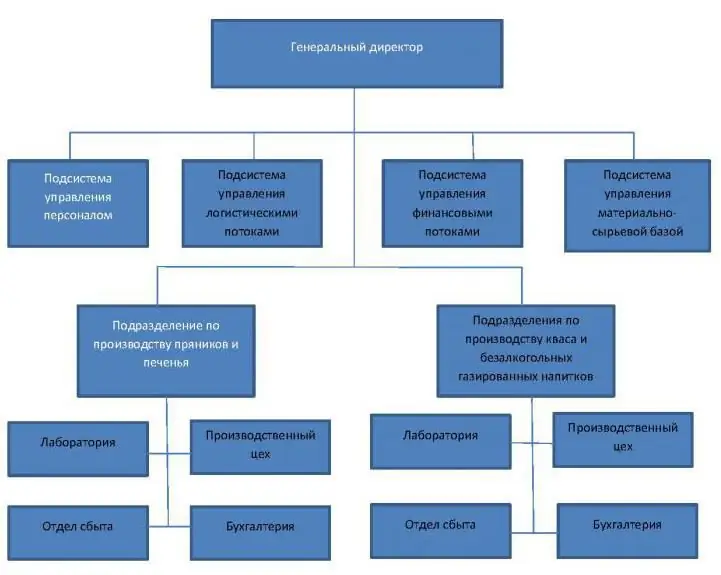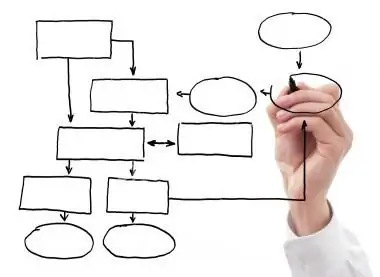2026 Author: Howard Calhoun | [email protected]. Last modified: 2025-01-24 13:10:29
The implementation of plans and programs is achieved by building an organizational structure that allows you to effectively direct the joint activities of staff through the appropriate distribution of duties, rights and responsibilities. The management of the enterprise should choose an organizational structure that is consistent with the strategic plans and ensures effective interaction with the environment and the achievement of the intended goals.

Characteristics of the organizational structure of the enterprise
Organizational structure refers to the formal scheme by which work tasks are divided, grouped and coordinated.
A characteristic of the organizational structure includes six main elements:
- specialization of work tasks;
- departmentalization;
- command chain;
- controllability rate (measured by the maximum number of subordinates for one leader);
- centralization and decentralization;
- formalization.
Traditional approaches to departmentalization
Specialization of work tasks consists in dividing the entire volume into separate elements and / or stages and assigning an employee to perform a narrow range of tasks, operations or procedures. The approach, on the basis of which individual work tasks are then grouped, is called departmentalization. There are five approaches to the formation of the structure of the organization:
1. The functional approach is that the grouping of work tasks and profile specialists into departments is carried out in accordance with the types of activity and qualifications - engineering department, accounting, marketing, production (Fig. 1).

Fig. one. Organizational structures of an enterprise: an example of a functional structure
2. With the divisional approach, the basis for the creation of self-sufficient divisions is the similarity of manufactured products and implemented programs or the influence of the geographical factor (Fig. 2).

Fig. 2. Organizational structures of an enterprise: an example of a divisional structure
3. The matrix approach consists in the coexistence of divisional and functional command chains, as a result of the intersection of which a double chain of subordination arises: employees at the same timeare accountable to two direct managers - the project or product manager, in the development or implementation of which they are involved, and the head of the functional department (Fig. 3).

Fig. 3. Organizational structures of an enterprise: an example of a matrix structure
New in company structures
The "new", more flexible and adaptive approaches to structure formation include:
- Team approach is used to organize the implementation of specific tasks. A variety of teams can be created to coordinate the activities of the main departments.
- In the network approach, the organization is "compressed", with the leading role and a key position in it is taken by the broker, whose role is to maintain interconnections with other departments using telecommunication technologies. Departments can be geographically scattered around the world, their activities are independent, the cost of the broker's services is paid based on the terms of the contract with the profit. Such a scheme of the organizational structure of the enterprise is reflected in fig. 4.

Fig.4. Organization network structure
Factors influencing the choice of structure
The choice of organizational structure is influenced by many situational factors both inside and outside the organization: the scale of the business, its specifics, the degree of mobility of the external environment, the characteristics of the industry in which the company operates, etc.
Advantages and disadvantagesadaptive and bureaucratic structures
The number of bureaucratic structures, which are also called hierarchical, include linear, functional, divisional, etc. Among the adaptive (organic) structures, matrix, project, network, etc. are distinguished. The characteristic features of these organizational structures are shown in table 1.
Table 1. Advantages and disadvantages of bureaucratic and adaptive organizational structures
| bureaucratic structure | Adaptive structure | |
| Pros |
• Having clear connections between subordinate and supervisor • Full control of subordinates • Rapid response to crises |
• Effective Motivation • High level of employee responsibility • Staff initiative • Rapid exchange of information between employees of different levels |
| Cons |
• Slow movement of information • Low employee accountability • Staff lack of initiative • Power Struggle |
• Probability of being out of control • Difficulties in finding qualified employees |
In general, organizational structures of an enterprise (for example, bureaucratic structures) are better suited to companies operating in a stable external environment, and organic ones are better suited to firms that are forced to work in conditions that change very quickly.
Comparative characteristicsorganizational structures
The organizational structure of an LLC enterprise, depending on the features of its construction, has clearly defined advantages and disadvantages, which are reflected in table 2.
Table 2. Comparative characteristics of organizational structures
| Name | Description | Benefits | Restrictions |
| Linear | The organization chart of an enterprise is created when tasks and powers are transferred from a manager to a subordinate, and so on through the chain of command. In this case, hierarchical levels of management are formed | Simplity and ease of control |
A manager of any rank must be competent and efficient in any managerial function. Effective management of a highly diversified and geographically branched business is impossible |
| Staff | A headquarters (administrative apparatus) is being created in the organization. Experts included in its composition (for example, lawyers, specialists in training and development of personnel, etc.) provide advice to top managers and line managers | Reducing the level of requirements for line managers and making their work easier | This type of organizational structure of an enterprise is characterized by the absence or limited power of the headquarters |
| Functional | For individual departments (production, sales, marketing, finance andetc.) certain management functions, tasks and responsibilities are clearly assigned | Optimization of activities in each functional area. It is most effective when the product range is relatively constant and the organization solves predominantly the same type of management tasks |
None of the departments as a whole is interested in achieving corporate goals, provokes conflicts between departments. Difficulties in preparing a senior talent pool due to the narrow specialization of middle managers. Slow response to environmental changes |
| Divisional | Dividing an organization into divisions by type of product or service, customer group or region |
Efficient structure for large, geographically dispersed companies with a wide range of products or services. Allows you to focus on specific products (services), consumer groups or regions. Responds quickly to changing technology, customer demand and competitive conditions |
Increased costs associated with duplication of work (including those performed by functional units) in different divisions |
| Project | Temporary structure created to solve a specific problem, limited by time. Headed by a project manager who reports to a team of specialists and who has the necessary resources at his disposal | All the efforts of employees are aimed at solving one specifictasks |
It is not possible to provide full or guaranteed employment for project participants after project completion. Problems with team workload and resource allocation |
| Matrix | The Matrix Organization is divided into structural (usually functional) divisions, and project managers are appointed who report to top management. During the implementation of projects, managers temporarily supervise the activities of employees of functional units. In everything that goes beyond the scope of project activities, these employees are subordinate to the heads of their departments |
Flexibility and speed of response to changes in the external environment. Possibility of prompt reallocation of resources |
Violation of the principle of unity of command due to the dual subordination of employees. The emergence of conflicts over the distribution of resources |
and others. There is simply no universal type of structure for all occasions.
Recommended:
Organizational structure of business and its development

The most important issue in any successful project is the structure of the business. After reading this article, you can easily evaluate your business development strategy and, if necessary, adjust it
The organizational structure of an organization is Definition, description, characteristics, advantages and disadvantages

The article reveals the concept of the organizational structure of an enterprise: what it is, how and in what forms it is used in modern enterprises. The attached diagrams will help to visually illustrate the use of different types of organizational structures
What is the project structure? Organizational structure of the project. Organizational structures of project management

The project structure is an important tool that allows you to divide the entire course of work into separate elements, which will greatly simplify it
Organizational structure of Russian Railways. Scheme of the management structure of Russian Railways. Structure of Russian Railways and its divisions

The structure of Russian Railways, in addition to the management apparatus, includes various dependent divisions, representative offices in other countries, as well as branches and subsidiaries. The head office of the company is located at: Moscow, st. New Basmannaya d 2
Economic and organizational characteristics of the enterprise. Brief description of LLC

What is an enterprise from an economic and organizational point of view? LLC example

